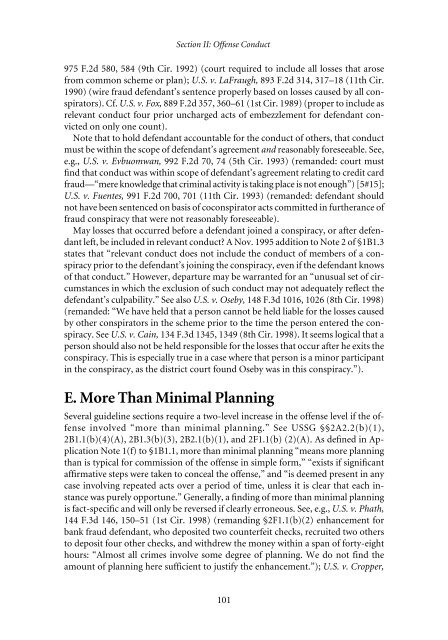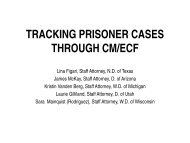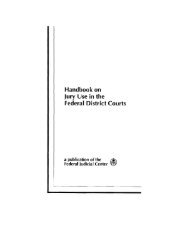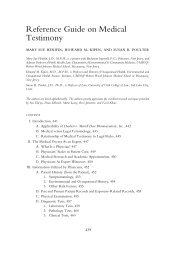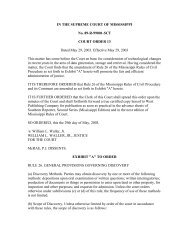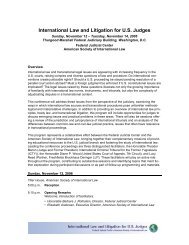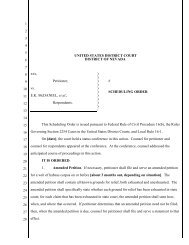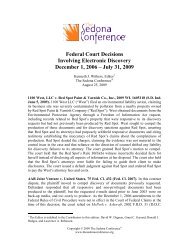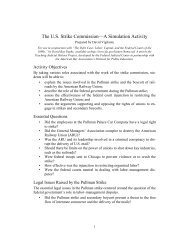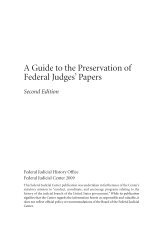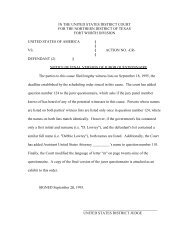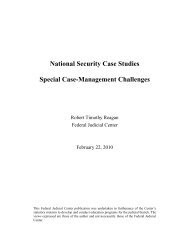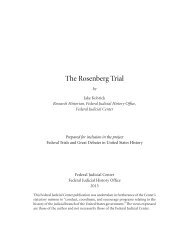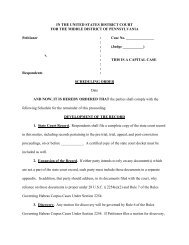- Page 1 and 2:
Guideline
- Page 3 and 4:
Contents I. General Application Pri
- Page 5 and 6:
Contents 4. Drug “Steerers,” Mi
- Page 7 and 8:
Contents c. Setting terms o
- Page 9 and 10:
Contents 1. Requirement for Governm
- Page 11 and 12:
This outline identifies significant
- Page 13 and 14:
Section I: General Application Prin
- Page 15 and 16:
Section I: General Application Prin
- Page 17 and 18:
Section I: General Application Prin
- Page 19 and 20:
Section I: General Application Prin
- Page 21 and 22:
Section I: General Application Prin
- Page 23 and 24:
Section I: General Application Prin
- Page 25 and 26:
Section I: General Application Prin
- Page 27 and 28:
Section I: General Application Prin
- Page 29 and 30:
Section I: General Application Prin
- Page 31 and 32:
E. Amendments 1. General Section I:
- Page 33 and 34:
3. Multiple Counts Section I: Gener
- Page 35 and 36:
Section I: General Application Prin
- Page 37 and 38:
Section I: General Application Prin
- Page 39 and 40:
Section I: General Application Prin
- Page 41 and 42:
Section I: General Application Prin
- Page 43 and 44:
Section I: General Application Prin
- Page 45 and 46:
K. Juvenile Sentencing</str
- Page 47 and 48:
Section II: Offense Conduct fenses,
- Page 49 and 50:
Section II: Offense Conduct c. Amou
- Page 51 and 52:
Section II: Offense Conduct 2. Rele
- Page 53 and 54:
Section II: Offense Conduct causes;
- Page 55 and 56:
Section II: Offense Conduct cocaine
- Page 57 and 58:
Section II: Offense Conduct finding
- Page 59 and 60: Section II: Offense Conduct §841(b
- Page 61 and 62: Section II: Offense Conduct as coca
- Page 63 and 64: Section II: Offense Conduct Acosta,
- Page 65 and 66: Section II: Offense Conduct directl
- Page 67 and 68: Section II: Offense Conduct maceuti
- Page 69 and 70: Section II: Offense Conduct mum sen
- Page 71 and 72: Section II: Offense Conduct tion fo
- Page 73 and 74: Section II: Offense Conduct gram);
- Page 75 and 76: Section II: Offense Conduct comment
- Page 77 and 78: Section II: Offense Conduct c. Chal
- Page 79 and 80: Section II: Offense Conduct <strong
- Page 81 and 82: Section II: Offense Conduct Several
- Page 83 and 84: Section II: Offense Conduct b. Manu
- Page 85 and 86: Section II: Offense Conduct In a pr
- Page 87 and 88: Section II: Offense Conduct the org
- Page 89 and 90: Section II: Offense Conduct v. Khan
- Page 91 and 92: Section II: Offense Conduct would u
- Page 93 and 94: Section II: Offense Conduct 172, 17
- Page 95 and 96: Section II: Offense Conduct v. Smit
- Page 97 and 98: Section II: Offense Conduct all cas
- Page 99 and 100: Section II: Offense Conduct cause a
- Page 101 and 102: Section II: Offense Conduct whateve
- Page 103 and 104: Section II: Offense Conduct not fac
- Page 105 and 106: Section II: Offense Conduct cording
- Page 107 and 108: Section II: Offense Conduct running
- Page 109: Section II: Offense Conduct v. Pre-
- Page 113 and 114: Section II: Offense Conduct to whic
- Page 115 and 116: Section II: Offense Conduct dresses
- Page 117 and 118: Section III: Adjustments (“find[i
- Page 119 and 120: Section III: Adjustments defendant
- Page 121 and 122: Section III: Adjustments 764, 771 (
- Page 123 and 124: Section III: Adjustments v. White,
- Page 125 and 126: Section III: Adjustments Newman, 96
- Page 127 and 128: Section III: Adjustments Park, 988
- Page 129 and 130: Section III: Adjustments not say th
- Page 131 and 132: Section III: Adjustments U.S.S.G.
- Page 133 and 134: Section III: Adjustments (remanded:
- Page 135 and 136: Section III: Adjustments is require
- Page 137 and 138: Section III: Adjustments d. Mitigat
- Page 139 and 140: Section III: Adjustments 1997) (rem
- Page 141 and 142: Section III: Adjustments users, but
- Page 143 and 144: Section III: Adjustments The Eleven
- Page 145 and 146: Section III: Adjustments The First
- Page 147 and 148: Section III: Adjustments 8. Abuse <
- Page 149 and 150: Section III: Adjustments ii. Victim
- Page 151 and 152: Section III: Adjustments bers <stro
- Page 153 and 154: Section III: Adjustments Similarly,
- Page 155 and 156: Section III: Adjustments 116 F.3d 1
- Page 157 and 158: Section III: Adjustments actually u
- Page 159 and 160: Section III: Adjustments elements <
- Page 161 and 162:
Section III: Adjustments justice.
- Page 163 and 164:
Section III: Adjustments 1069, 1071
- Page 165 and 166:
Section III: Adjustments The Ninth
- Page 167 and 168:
Section III: Adjustments e. Flight
- Page 169 and 170:
Section III: Adjustments were requi
- Page 171 and 172:
Section III: Adjustments 1992); U.S
- Page 173 and 174:
Section III: Adjustments Gonzalez,
- Page 175 and 176:
Section III: Adjustments does not a
- Page 177 and 178:
Section III: Adjustments though thi
- Page 179 and 180:
Section III: Adjustments ing invest
- Page 181 and 182:
Section III: Adjustments remains th
- Page 183 and 184:
Section III: Adjustments confusion
- Page 185 and 186:
Section III: Adjustments of
- Page 187 and 188:
Section III: Adjustments There is s
- Page 189 and 190:
Section III: Adjustments E. Accepta
- Page 191 and 192:
Section III: Adjustments one factor
- Page 193 and 194:
Section III: Adjustments erly refus
- Page 195 and 196:
Section III: Adjustments ing the ev
- Page 197 and 198:
Section III: Adjustments cere remor
- Page 199 and 200:
Section III: Adjustments ment, she
- Page 201 and 202:
Section III: Adjustments the govern
- Page 203 and 204:
Section III: Adjustments Purchess,
- Page 205 and 206:
Section III: Adjustments The Ninth
- Page 207 and 208:
Section III: Adjustments after thei
- Page 209 and 210:
Section III: Adjustments defendants
- Page 211 and 212:
IV. Criminal History A. Calculation
- Page 213 and 214:
Section IV: Criminal History (Nevad
- Page 215 and 216:
Section IV: Criminal History wise t
- Page 217 and 218:
Section IV: Criminal History Commis
- Page 219 and 220:
Section IV: Criminal History Bleike
- Page 221 and 222:
Section IV: Criminal History not le
- Page 223 and 224:
Section IV: Criminal History the al
- Page 225 and 226:
Section IV: Criminal History ment t
- Page 227 and 228:
Section IV: Criminal History histor
- Page 229 and 230:
Section IV: Criminal History ris, 9
- Page 231 and 232:
Section IV: Criminal History Note t
- Page 233 and 234:
Section IV: Criminal History Some c
- Page 235 and 236:
Section IV: Criminal History discus
- Page 237 and 238:
Section IV: Criminal History After
- Page 239 and 240:
Section IV: Criminal History court
- Page 241 and 242:
Section IV: Criminal History “in
- Page 243 and 244:
Section IV: Criminal History C. Cri
- Page 245 and 246:
Section IV: Criminal History found
- Page 247 and 248:
Section IV: Criminal History refere
- Page 249 and 250:
2. Pending State Sentences Section
- Page 251 and 252:
Section V: Determining the Sentence
- Page 253 and 254:
Section V: Determining the Sentence
- Page 255 and 256:
Section V: Determining the Sentence
- Page 257 and 258:
Section V: Determining the Sentence
- Page 259 and 260:
Section V: Determining the Sentence
- Page 261 and 262:
Section V: Determining the Sentence
- Page 263 and 264:
Section V: Determining the Sentence
- Page 265 and 266:
Section V: Determining the Sentence
- Page 267 and 268:
Section V: Determining the Sentence
- Page 269 and 270:
Section V: Determining the Sentence
- Page 271 and 272:
Section V: Determining the Sentence
- Page 273 and 274:
Section V: Determining the Sentence
- Page 275 and 276:
Section V: Determining the Sentence
- Page 277 and 278:
Section V: Determining the Sentence
- Page 279 and 280:
Section V: Determining the Sentence
- Page 281 and 282:
Section V: Determining the Sentence
- Page 283 and 284:
Section V: Determining the Sentence
- Page 285 and 286:
Section V: Determining the Sentence
- Page 287 and 288:
Section V: Determining the Sentence
- Page 289 and 290:
Section V: Determining the Sentence
- Page 291 and 292:
Section V: Determining the Sentence
- Page 293 and 294:
Section V: Determining the Sentence
- Page 295 and 296:
Section V: Determining the Sentence
- Page 297 and 298:
Section V: Determining the Sentence
- Page 299 and 300:
VI. Departures A. Criminal History
- Page 301 and 302:
Section VI: Departures b. Remote co
- Page 303 and 304:
Section VI: Departures on the basis
- Page 305 and 306:
Section VI: Departures Myers, 41 F.
- Page 307 and 308:
Section VI: Departures h. Disciplin
- Page 309 and 310:
Section VI: Departures of</
- Page 311 and 312:
Section VI: Departures ture, but fo
- Page 313 and 314:
Section VI: Departures render moot
- Page 315 and 316:
Section VI: Departures fense levels
- Page 317 and 318:
Section VI: Departures Cir. 1992) (
- Page 319 and 320:
Section VI: Departures 914 F.2d 134
- Page 321 and 322:
Section VI: Departures to compare O
- Page 323 and 324:
Section VI: Departures engaging in
- Page 325 and 326:
Section VI: Departures i. Specific
- Page 327 and 328:
Section VI: Departures 3. Upward De
- Page 329 and 330:
Section VI: Departures c. Mental he
- Page 331 and 332:
Section VI: Departures time to §5K
- Page 333 and 334:
Section VI: Departures plays a cruc
- Page 335 and 336:
Section VI: Departures certain emot
- Page 337 and 338:
Section VI: Departures robbery by a
- Page 339 and 340:
Section VI: Departures noting that
- Page 341 and 342:
Section VI: Departures On the other
- Page 343 and 344:
Section VI: Departures d. Extreme v
- Page 345 and 346:
Section VI: Departures asthma becau
- Page 347 and 348:
Section VI: Departures that impriso
- Page 349 and 350:
Section VI: Departures child is in
- Page 351 and 352:
Section VI: Departures extraordinar
- Page 353 and 354:
Section VI: Departures manded: may
- Page 355 and 356:
Section VI: Departures with drugs s
- Page 357 and 358:
Section VI: Departures §5K2.12. U.
- Page 359 and 360:
Section VI: Departures nipulation
- Page 361 and 362:
Section VI: Departures fered by Col
- Page 363 and 364:
Section VI: Departures ing, outrage
- Page 365 and 366:
Section VI: Departures ecution afte
- Page 367 and 368:
Section VI: Departures departure ba
- Page 369 and 370:
Section VI: Departures parture unde
- Page 371 and 372:
Section VI: Departures 88 (9th Cir.
- Page 373 and 374:
Section VI: Departures (affirming d
- Page 375 and 376:
Section VI: Departures recommend pr
- Page 377 and 378:
Section VI: Departures creased sent
- Page 379 and 380:
Section VI: Departures separate cri
- Page 381 and 382:
Section VI: Departures (remanded) [
- Page 383 and 384:
Section VI: Departures v. Brown, 91
- Page 385 and 386:
Section VI: Departures the district
- Page 387 and 388:
Section VI: Departures imprecisions
- Page 389 and 390:
Section VI: Departures and that a g
- Page 391 and 392:
Section VI: Departures make motion
- Page 393 and 394:
Section VI: Departures courts have
- Page 395 and 396:
Section VI: Departures hold the mot
- Page 397 and 398:
Section VI: Departures 1997) (court
- Page 399 and 400:
Section VI: Departures The Third Ci
- Page 401 and 402:
Section VI: Departures either a §5
- Page 403 and 404:
Section VI: Departures more restric
- Page 405 and 406:
Section VI: Departures sentence was
- Page 407 and 408:
Section VI: Departures G. Notice Re
- Page 409 and 410:
Section VI: Departures The reasons
- Page 411 and 412:
Section VII: Violation of</
- Page 413 and 414:
Section VII: Violation of</
- Page 415 and 416:
Section VII: Violation of</
- Page 417 and 418:
Section VII: Violation of</
- Page 419 and 420:
Section VII: Violation of</
- Page 421 and 422:
Section VII: Violation of</
- Page 423 and 424:
Section VIII: Sentencing</s
- Page 425 and 426:
Section IX: Sentencing</str
- Page 427 and 428:
Section IX: Sentencing</str
- Page 429 and 430:
Section IX: Sentencing</str
- Page 431 and 432:
Section IX: Sentencing</str
- Page 433 and 434:
Section IX: Sentencing</str
- Page 435 and 436:
Section IX: Sentencing</str
- Page 437 and 438:
Section IX: Sentencing</str
- Page 439 and 440:
Section IX: Sentencing</str
- Page 441 and 442:
Section IX: Sentencing</str
- Page 443 and 444:
Section IX: Sentencing</str
- Page 445 and 446:
Section IX: Sentencing</str
- Page 447 and 448:
Section IX: Sentencing</str
- Page 449 and 450:
Section IX: Sentencing</str
- Page 451 and 452:
Section IX: Sentencing</str
- Page 453 and 454:
Section IX: Sentencing</str
- Page 455 and 456:
Section X: Appellate</stron
- Page 457 and 458:
Section X: Appellate</stron
- Page 459 and 460:
Section X: Appellate</stron
- Page 461 and 462:
Section X: Appellate</stron
- Page 463 and 464:
Aquilera-Zapata, 901 F.2d 1209 (5th
- Page 465 and 466:
Boyd, 885 F.2d 246 (5th Cir. 1989)
- Page 467 and 468:
Chen, 127 F.3d 286 (2d Cir. 1997) 2
- Page 469 and 470:
Deane, 914 F.2d 11 (1st Cir. 1990)
- Page 471 and 472:
Fisher, 58 F.3d 96 (4th Cir. 1995)
- Page 473 and 474:
Graham, 72 F.3d 352 (3d Cir. 1995)
- Page 475 and 476:
Houser, 70 F.3d 87 (11th Cir. 1995)
- Page 477 and 478:
Kimble, 107 F.3d 712 (9th Cir. 1997
- Page 479 and 480:
Mackbee, 894 F.2d 1057 (9th Cir. 19
- Page 481 and 482:
Mills, 959 F.2d 516 (5th Cir. 1992)
- Page 483 and 484:
O’Neil, 118 F.3d 65 (2d Cir. 1997
- Page 485 and 486:
R R.L.C., 112 S. Ct. 1329 (1992) 35
- Page 487 and 488:
Rust, 976 F.2d 55 (1st Cir. 1992) 1
- Page 489 and 490:
Smith, 929 F.2d 1453 (10th Cir. 199
- Page 491 and 492:
Trujeque, 100 F.3d 869 (10th Cir. 1
- Page 493 and 494:
Williams, 103 F.3d 57 (8th Cir. 199


